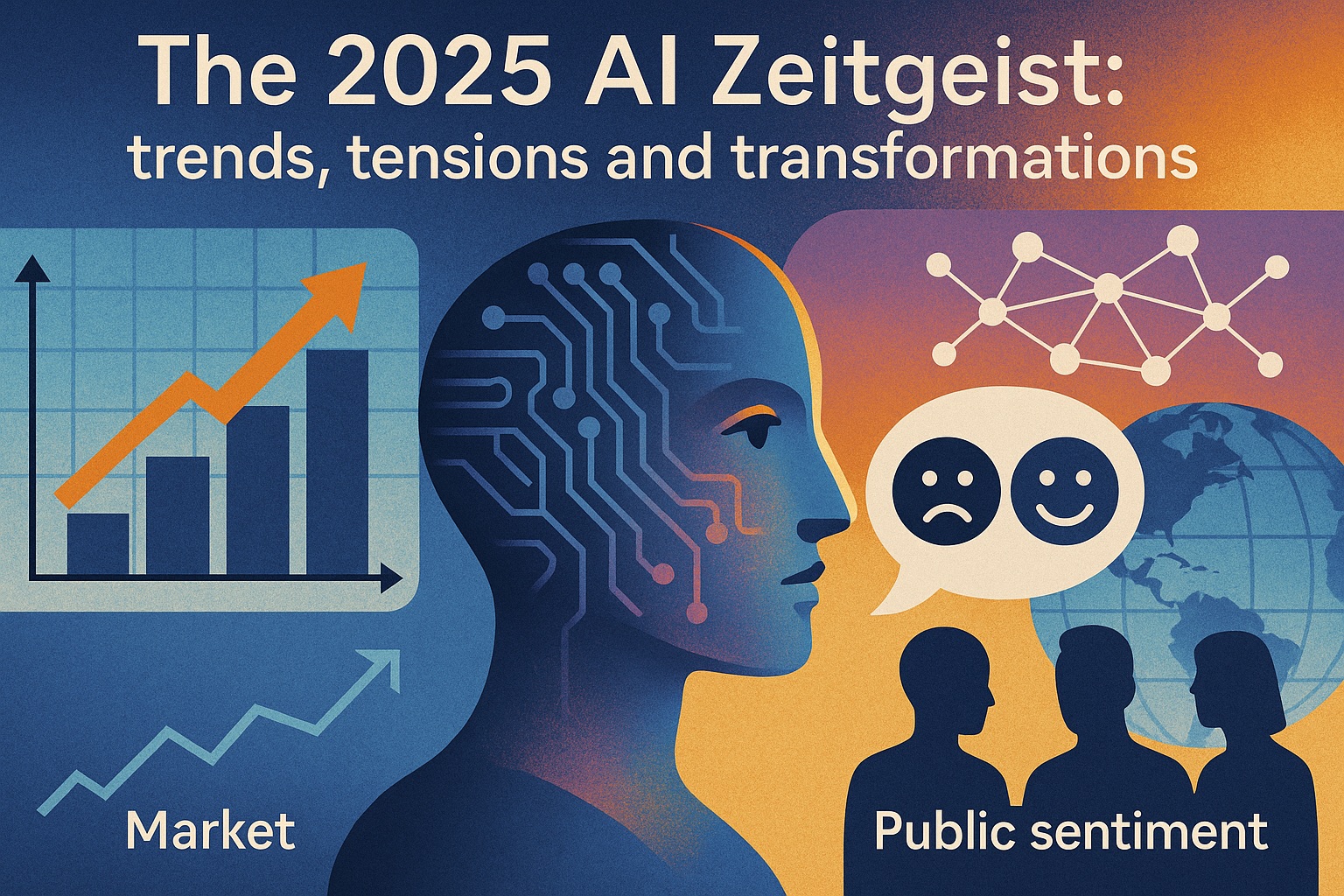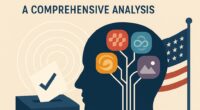Artificial intelligence (AI) is evolving from a novel technology into a social and economic force. In mid‑2025 the global AI conversation is dominated by transformative market growth, rapidly improving models and mounting sociopolitical tensions. To build a holistic picture of this “AI Zeitgeist,” this report synthesises data from diverse sources including the Stanford AI Index 2025, market analysis firms, opinion surveys, policy announcements and technical updates. It assesses four dimensions: market dynamics, public sentiment, technical breakthroughs and sociopolitical shifts. Throughout the report dates are provided to avoid confusion with relative terms such as “today” or “this year”; all information is current as of July 22 2025 (Europe/Berlin time).
Market dynamics
Global market size and investment
The AI industry continues to expand at an unprecedented pace. Estimates vary because of different definitions, but they all point to rapid growth and large capital flows:
| Metric (research source, date) | Value | Notes |
|---|---|---|
| Global AI market size in 2025 (Precedence Research, May 2025)precedenceresearch.com | US$757.6 B | Precedence Research estimates the 2025 AI market at US$757.58 billion and forecasts it to reach US$3.68 trillion by 2034 at a compound annual growth rate (CAGR) of 19.2 %. North America held 36.9 % of the market in 2024precedenceresearch.com. |
| Alternative valuation (Fortune Business Insights, June 2025)fortunebusinessinsights.com | US$294.2 B in 2025 | Fortune Business Insights values the AI market at US$233.46 billion in 2024 and projects growth to US$294.16 billion in 2025, reaching US$1.77 trillion by 2032 (CAGR 29.2 %). It notes that 35 % of businesses have integrated AI and that nine out of ten use AI for competitive advantagefortunebusinessinsights.com. |
| Private AI investment (Stanford AI Index 2025)hai.stanford.edu | US$252.3 B (2024) | Corporate AI investment, which includes internal spending and external investments, reached US$252.3 billion in 2024, up 44.5 % from 2023hai.stanford.edu. The U.S. contributed US$109.1 billion, more than 12 times China’s US$9.3 billion and 24 times the UK’s US$4.5 billionhai.stanford.edu. Generative‑AI investment reached US$33.9 billion in 2024hai.stanford.edu. |
These estimates reveal two themes: (1) capital is rapidly accelerating into AI and (2) the U.S. retains a dominant share of private investment. However, the gap between the U.S. and China is narrowing in certain sub‑sectors (e.g., robotics) and the European Union aims to boost its investment with targeted policies.
Corporate adoption and productivity impacts
- Adoption levels: The share of organisations using AI climbed from 55 % in 2023 to 78 % in 2024, and 71 % now employ generative AIhai.stanford.edu. Sectors such as banking, finance, manufacturing and health care report some of the highest adoption rates.
- Impact on costs and revenue: Companies report cost reductions and revenue increases, but the magnitude is modest; in most surveyed firms AI reduces costs by less than 10 % and raises revenue by under 5 %hai.stanford.edu. Meaningful benefits often require re‑engineering workflows and training staff.
- Robotics and automation: China installed 276,300 industrial robots in 2023, more than six times Japan’s level and 7.3 times the U.S.hai.stanford.edu. Collaborative robots’ share of installations rose from 2.8 % in 2017 to 10.5 % in 2023hai.stanford.edu, highlighting a shift toward robots that work alongside humans.
Consumer adoption and monetisation
- Usage prevalence: Menlo Ventures’ State of Consumer AI 2025 survey found that 61 % of U.S. adults used an AI product in the previous six months, and globally 1.7–1.8 billion people used AI, with 500–600 million daily usersmenlovc.com. Among working adults, 75 % use AI, and adoption is particularly high among millennials and high‑income householdsmenlovc.com.
- Revenue model: Despite widespread use, the consumer AI market generated only about US$12 billion in revenue because fewer than 3 % of users pay for servicesmenlovc.com. Most consumer AI applications rely on advertising or cross‑subsidisation.
- Differential usage: 79 % of parents use AI, often for child‑related tasks such as scheduling and homework assistancemenlovc.com. AI adoption is correlated with income: high‑income households use AI at rates almost double those of low‑income householdsmenlovc.com.
Public sentiment and societal tensions
Global attitudes toward AI
Recent surveys reveal a complex mix of optimism, anxiety and calls for regulation:
- Perceived benefits vs harms: The AI Index 2025 public opinion chapter reports that the share of people who believe AI products will mostly help rather than harm rose from 52 % in 2022 to 55 % in 2024hai.stanford.edu. Yet trust in companies to handle data responsibly fell from 50 % to 47 %, and only 36 % believe AI will improve the economyhai.stanford.edu.
- Excitement and nervousness: Ipsos’s 2025 AI Monitor finds 52 % of respondents are excited about AI products/services, while 53 % report feeling nervousipsos.com. Approximately 67 % expect AI to change their lives within three to five yearsipsos.com.
- Trust and regulation: KPMG’s global study shows that 66 % of people use AI regularly and 83 % expect a wide range of benefits, but only 46 % are willing to trust AI systems, and 70 % believe national or international regulation is neededkpmg.com. Moreover, 66 % rely on AI outputs without checking them, and 56 % have made mistakes due to AIkpmg.com.
- Regional differences: Optimism is higher in emerging economies. In countries like Nigeria and India, more than 70 % trust AI systems, whereas trust in advanced economies such as Germany, Finland and Japan is closer to 25–30 %assets.kpmg.com. In the U.S. and Canada only about 40 % of people are optimistic about AI’s benefitshai.stanford.edu.
Employment and workforce perceptions
- Jobs and automation: Pew Research’s 2025 AI & Jobs survey (U.S.) finds that 64 % of adults think AI will lead to fewer jobs in the next 20 years, while only 39 % of AI experts share that viewpewresearch.org. 56 % of adults are extremely or very concerned about job losses; experts are less worriedpewresearch.org. Both groups, however, agree that bias and fairness are significant concernspewresearch.org.
- Skill gaps and training: KPMG’s Australia survey notes that 65 % of Australian employees report that their employers use AI, and 49 % intentionally use AI themselves, yet only 24 % have received any AI‑related trainingkpmg.com. 48 % admit to making mistakes because of AI, emphasising the need for literacy and governancekpmg.com.
Key tensions
- Trust vs adoption: People are using AI more than ever but do not fully trust it. Survey respondents want robust regulation and standards, yet many continue using AI tools uncritically, leading to mistakeskpmg.com.
- Optimism vs anxiety: Optimistic attitudes are driven by perceived convenience, improved productivity and creative opportunities. Anxiety stems from job displacement, privacy risks, misinformation and potential bias, with differences across regions and socioeconomic groupshai.stanford.edu.
- Emerging vs advanced economies: Emerging economies show higher trust and acceptance partly because AI can leapfrog infrastructure gaps and drive economic growthassets.kpmg.com. Advanced economies are more sceptical, reflecting concerns over labour markets, data privacy and ethical considerations.assets.kpmg.com
Technical breakthroughs and efficiency gains
Model performance and scale
The past year witnessed remarkable improvements in AI capabilities:
- Benchmark leaps: Between 2024 and 2025, top AI models improved performance on new multidisciplinary benchmarks. In the Baytech Consulting analysis summarising the AI Index, scores on the MMMU benchmark rose 18.8 points, GPQA by 48.9 points and SWE‑bench by 67.3 pointsbaytechconsulting.com. The performance gap between the top model and the tenth‑best model narrowed, with the Elo score difference shrinking from 11.9 % to 5.4 %baytechconsulting.com.
- Human vs AI performance: AI now outperforms humans four‑fold on tasks requiring two hours or less, but humans still excel when given prolonged time (32 hours), outperforming AI by a factor of twobaytechconsulting.com. This suggests that AI excels at rapid synthesis and routine tasks but still struggles with long‑horizon reasoning or tasks requiring deep understanding.
Efficiency and small language models
- Parameter efficiency: Small language models (SLMs) such as Microsoft’s Phi‑3‑Mini (3.8 billion parameters) can match the performance of models over 500 billion parameters. This represents a 142‑fold reduction in size while maintaining competitive qualitybaytechconsulting.com.
- Cost declines: The cost of inference has fallen dramatically. In November 2022 it cost about US$20 per million tokens. By October 2024, using Google’s Gemini‑1.5‑Flash‑8B, the cost dropped to US$0.07 per million tokens—a ~280‑fold decreasebaytechconsulting.com. Inference prices are dropping 9× to 900× per year as hardware and software improvebaytechconsulting.com. Hardware costs decline around 30 % annually, and energy efficiency improves 40 % per yearbaytechconsulting.com.
Model and tool landscape
- New large language models: Recent models include Llama 3 (open‑source, up to 70 billion parameters and 128 k context window), Claude 4 Sonnet (Anthropic’s model with 200K token context and extended reasoning modes), Mistral Small 3 (24 billion parameters with low‑latency open‑source architecture), Gemini 2.5 (Google’s multimodal model offering 1 million‑token context and self‑fact‑checking), and Cohere Command R+ (enterprise‑focused RAG model with citations)shakudo.io. Open models such as Gemma and Phi‑3 are fostering a vibrant ecosystem.
- Generative media advances: Google’s 2024–25 updates include Veo 2 (high‑quality text‑to‑video), Imagen 3 (photorealistic image generation), and Project Astra (multimodal agent that can identify objects in real time). They also released Gemini 1.5 Pro and 1.5 Flash, and integrated generative AI into Search and Workspaceblog.googleblog.google. New robotics systems like ALOHA Unleashed and AutoRT demonstrate rapid adaptation and generalisation to physical tasksblog.google.
- Hardware and quantum: Google announced AlphaChip, a custom AI accelerator with improved efficiency, and a quantum chip called “Willow” capable of performing certain computations millions of times faster than classical computersblog.google. These advances hint at a future where specialised hardware and quantum computing complement general‑purpose AI models.
Sociopolitical shifts
Regulatory frameworks
The regulatory landscape diverges across regions, balancing innovation with safety concerns:
- European Union: The AI Act entered into force on 1 August 2024 and introduces a risk‑based framework. Prohibited applications (behavioural manipulation, social scoring, real‑time biometric identification for law enforcement, predictive policing) will be banned by 2 February 2025crowell.com. Providers of general‑purpose AI (GPAI) models must, by August 2025, publish technical documentation, summaries of training data, copyright compliance statements and cooperate with EU authoritiescrowell.com. High‑risk system obligations will apply in 2027crowell.com. The Act is enforced by an AI Office within the European Commission, and codes of practice are expected by May 2025crowell.com.
- United States: On 23 January 2025, the new U.S. administration issued an executive order titled “Removing Barriers to American Leadership in AI.” It revoked the 2023 Biden order and directs agencies to remove or revise regulations that hinder AI innovation, emphasising free‑market principleswhitehouse.gov. Agencies are asked to develop an AI action plan within 180 days (due July 2025) to sustain U.S. dominancewhitehouse.gov. This policy shift creates uncertainty about privacy and safety protections established under the previous administrationworkforcebulletin.com.
- United Kingdom: The UK pursues a pro‑innovation approach, relying on existing sector‑specific regulators rather than a single AI law. It introduced five guiding principles—safety, transparency, fairness, accountability and contestabilitycimplifi.com. A voluntary AI Safety Institute tests frontier models, and the country plans to host a follow‑up AI Safety Summit.
- Other jurisdictions: Canada’s proposed Artificial Intelligence and Data Act (AIDA) stalled when its enabling bill died in committee in January 2025cimplifi.com. China enacted generative‑AI measures requiring lawful, non‑discriminatory content and clear labelling; final measures take effect on 1 September 2025cimplifi.com. Brazil’s AI bill awaits Senate approvalcimplifi.com.
Global cooperation and safety summits
- AI Seoul Summit (May 2024): 27 nations agreed to develop shared thresholds for severe AI risks and committed to safety frameworks, promising to involve companies, civil society and academia in governancegov.uk. Sixteen AI companies signed safety commitments and pledged to embed risk management into their development processesgov.uk. France will host the next summit, emphasising continuous global dialogue.
- AI Safety Institutes: Multiple countries—including the U.S., UK, EU and Canada—announced national AI safety institutes in 2024–25hai.stanford.edu. These bodies aim to test frontier models, set evaluation standards and provide transparent reporting on safety features.
Legislative momentum and patchwork regulation
- Proliferation of laws: The number of U.S. states enacting AI legislation surged from one in 2016 to 131 by 2024, reflecting a fragmented regulatory environmenthai.stanford.edu. Deepfake regulations were in place in 24 U.S. states by 2024hai.stanford.edu. Globally, references to AI in parliamentary records across 75 countries increased by 21.3 % in 2024hai.stanford.edu.
- Government investments: Governments are investing heavily: Canada pledged CA$2.4 billion for AI infrastructure and safe adoption, China launched a US$47.5 billion fund to boost domestic AI, France allocated €109 billion, India US$1.25 billion, and Saudi Arabia US$100 billionhai.stanford.edu. These investments aim to build local ecosystems while competing for global leadership.
Key tensions
- Innovation vs safety: The EU AI Act sets strict obligations, while the U.S. has shifted toward deregulation, creating a transatlantic contrast. Businesses must navigate a patchwork of rules and potential compliance costs.
- National competition vs global cooperation: Countries compete for AI supremacy yet recognise the need for shared safety standards, as shown by the AI Seoul Summit and subsequent creation of AI safety institutesgov.uk.
- Regulatory uncertainty: Shifts in U.S. policy and delays in Canada’s AIDA create uncertainty for companies operating across borders. China’s rules emphasise sovereignty and content controlscimplifi.com, while Brazil’s bill is pending, reflecting a broader divergence in global approaches.
Synthesis: transformations and outlook
The AI landscape in 2025 is characterised by explosive growth tempered by public unease and regulatory friction. Markets continue to expand, with investment and adoption soaring across corporate and consumer sectors. Technological breakthroughs—both in raw performance and efficiency—are reducing the cost barrier, enabling small models to achieve parity with giants and fostering a vibrant open‑source ecosystem. Generative AI is permeating creative industries, robotics is stepping out of factories into everyday environments, and specialised hardware and quantum chips herald new computational frontiers.
At the same time, societal tensions persist. Surveys reveal high usage juxtaposed with low trust; optimism about AI’s potential coexists with anxiety about job displacement, bias and privacy. Attitudes vary by region and socioeconomic status, with emerging economies embracing AI’s promise while advanced economies adopt a more cautious stanceassets.kpmg.com. Governments respond unevenly: the EU leads with a comprehensive AI Act, the U.S. oscillates between regulation and deregulation, and other nations propose or delay their own laws.
Transformative forces shaping the AI zeitgeist include:
- Democratisation of AI: Falling inference costs and the rise of efficient SLMs mean that powerful AI becomes accessible to startups, researchers and individuals, not just tech giantsbaytechconsulting.com.
- Hybrid human–AI workflows: AI surpasses humans in short‑duration tasks but relies on human expertise for long‑horizon reasoningbaytechconsulting.com. Organisations must design complementary workflows and invest in up‑skilling.
- Global regulatory divergence: Firms must navigate a complex regulatory mosaic, aligning products with Europe’s risk‑based rules while adapting to shifting U.S. policies and emerging regulations in Asia and the Americas.
- Public demand for trust: Building trustworthy AI requires transparency, fairness and effective regulation. Without addressing privacy and bias concerns, adoption may plateau despite technical advancementskpmg.com.
Conclusion
The 2025 AI zeitgeist is defined by trends of exponential market growth and technical leaps, tensions arising from trust deficits and regulatory uncertainty, and transformations that make AI more efficient, accessible and integrated into daily life. Understanding these dynamics is essential for policymakers, businesses and citizens as they navigate an era in which AI is no longer speculative but a core driver of economic and social change. Continued dialogue among governments, industry and civil society—as exemplified by global AI safety summits—will be crucial to harnessing AI’s benefits while mitigating its risks.









